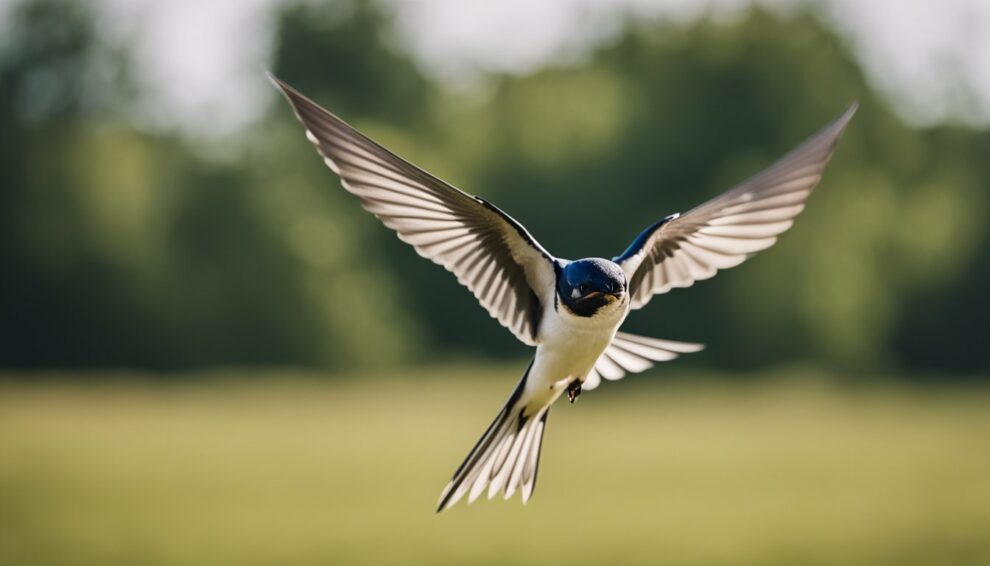Swallows are known for their graceful flight and aerial acrobatics.
They belong to the family Hirundinidae and can be found on every continent except Antarctica.
With their streamlined bodies and long, pointed wings, swallows are perfectly adapted for catching insects on the wing.

The aerial acrobatics of swallows are truly a sight to behold.
These birds possess exceptional flight skills, often performing incredible maneuvers as they chase after flying insects.
Their long, slender bodies and wings make them superb flyers capable of covering long distances during migration.
From the Tree Swallow’s endless, circling feeding sweeps during the day to the Barn Swallow’s swooping dives and turns, each species of swallow has its own unique flight dynamics.
Understanding the flight dynamics of swallows can help us appreciate the beauty and complexity of their aerial acrobatics.
From the physics of lift and drag to the intricacies of wing shape and movement, there is much to learn about these amazing creatures.
In this article, we will explore the flight mechanics of swallows and gain a deeper understanding of how they are able to perform such incredible aerial feats.
The Marvel of Swallow Flight
Swallows are known for their exceptional flight skills, often performing aerial acrobatics as they chase after flying insects.
Their smooth, flowing flight and pointed wings make them beautiful and graceful fliers.
They possess long, slender bodies and wings, characteristics that make them superb flyers capable of covering long distances during migration.
Anatomy of Agility
Swallows have a unique anatomy that allows them to be agile and maneuverable in the air.
Their forked tail, for instance, provides them with greater control and stability during flight.
The tail allows them to make sharp turns and sudden stops, making them effective hunters of flying insects.
The wings of swallows are also designed for agility. They have narrow, pointed wings that allow them to fly at high speeds and make quick turns.
Their wings also have a high aspect ratio, which means that they are long and narrow in shape, providing them with greater lift and reduced drag.
Flight Techniques and Behaviors
Swallows use a variety of flight techniques and behaviors to catch their prey.
They often fly low over water bodies, such as ponds and lakes, to catch insects that are hovering over the surface.
They also perform aerial acrobatics, such as sudden twists and turns, to catch insects on the wing.
Swallows are aerial insectivores, meaning that they feed exclusively on flying insects.
They have a high metabolism, which means that they need to eat regularly to maintain their energy levels.
During migration, swallows can fly up to 200 miles per day, covering vast distances in search of food.
In conclusion, swallows are fascinating creatures that have evolved unique adaptations to survive and thrive in their environment.
Their aerial acrobatics and hunting techniques are a marvel of nature, showcasing the incredible diversity and complexity of the natural world.
Swallow Habitats and Migration Patterns

Swallows are fascinating birds that are known for their incredible aerial acrobatics.
These birds are found all around the world, including in North and South America.
Swallows are migratory birds, which means that they travel long distances every year to find the perfect habitat for breeding and feeding.
From North to South: The Journey
Swallows are known for their impressive migration patterns.
Every year, these birds travel thousands of miles from their summer breeding grounds in the north to their winter habitats in the south.
The journey can take several weeks, and swallows have to fly over mountains, oceans, and deserts to reach their destination.
The migration routes of swallows vary depending on the species.
For example, the barn swallow is the most widespread swallow species in the world, covering 251 million square kilometers.
These birds migrate from North America to South America, crossing the Gulf of Mexico and the Amazon rainforest.
On the other hand, the tree swallow migrates from Canada to the southern United States and Mexico.
Choosing the Perfect Home
Swallows are very particular about their habitats. They need open spaces and clear skies to fly and catch insects.
Swallows can be found in a variety of habitats, including marshes, fields, meadows, and even urban areas.
These birds prefer to nest in tree cavities and old buildings, but they also readily take up residence in nest boxes.
The choice of habitat depends on the species and the season.
For example, tree swallows prefer open habitats with water nearby, such as wetlands and marshes during the breeding season.
During the winter, they move to warmer areas with abundant food sources.
On the other hand, barn swallows prefer open fields and meadows during the breeding season, but they move to more urban areas during the winter.
In conclusion, understanding the habitats and migration patterns of swallows is essential to protect these amazing birds.
Swallows play a crucial role in the ecosystem by controlling insect populations and pollinating plants.
By providing suitable habitats and protecting their migration routes, we can ensure that these birds continue to thrive for generations to come.
The Life Cycle of Swallows

Swallows are fascinating birds that are known for their aerial acrobatics and unique nest-building abilities.
In this section, we will explore the life cycle of swallows, from egg to fledgling, and the social dynamics of swallow colonies.
From Egg to Fledgling
Swallows typically breed in the spring, with May being a particularly active month for nesting.
The female swallow lays a clutch of 3-7 eggs in a nest made of mud pellets and other materials, such as grass and feathers.
The nest is usually located in a tree cavity or a man-made structure, such as a barn or building ledge.
After about two weeks of incubation, the eggs hatch, and the nestlings are born.
The parents work together to feed the nestlings a diet of insects, which they catch while in flight.
The nestlings grow quickly and are ready to fledge, or leave the nest, after about three weeks.
The Social Dynamics of Swallow Colonies
Swallows are social birds that often form colonies. These colonies can range in size from just a few pairs to hundreds of pairs.
Swallows communicate with each other using a variety of vocalizations and body language.
In a colony, each pair of swallows defends its own nesting site from other swallows.
However, they also work together to defend the colony as a whole from predators.
Swallows are also known for their communal roosting behavior, where they gather in large numbers at night to sleep.
Overall, the life cycle of swallows is a fascinating example of the intricate social dynamics and unique adaptations of these remarkable birds.
Swallows and Their Role in Ecosystems

Swallows are fascinating birds that play an important role in many ecosystems.
These aerial acrobats are highly skilled at catching insects in mid-air, making them valuable for controlling insect populations.
They are a naturalist’s dream, as they provide a natural form of pest control, reducing the need for harmful pesticides.
Conservationists also appreciate the role of swallows in ecosystems.
These birds are an important part of the food chain, providing a source of food for predators such as hawks and owls.
They are also a source of omega-3 fatty acids, which are essential for many animals, including humans.
Swallows are highly social birds, often living in large groups. They are monogamous, meaning that they mate for life and raise their young together.
They are also known for their impressive aerial displays, which are often used to attract mates or to establish territory.
Farmers also appreciate the role of swallows in controlling insect populations.
These birds are often seen following plows or mowers, catching insects that have been stirred up in the process.
They are also attracted to birdhouses, making them a popular addition to many farms and gardens.
In conclusion, swallows are fascinating creatures that play an important role in many ecosystems.
Their impressive aerial acrobatics and natural pest control abilities make them valuable to both naturalists and conservationists alike.
By providing a source of food for predators and essential nutrients for many animals, swallows are an essential part of the food chain.
Frequently Asked Questions

What adaptations allow swallows to perform complex aerial maneuvers?
Swallows are known for their incredible aerial acrobatics, which they achieve through a combination of physical adaptations and innate abilities.
Their streamlined bodies, long wings, and forked tails make them perfectly suited for high-speed flight and intricate maneuvers.
Swallows also possess a highly developed visual system that allows them to track prey and navigate through complex environments with ease.
Can you explain how swallows achieve such precision while flying at high speeds?
Swallows are able to achieve remarkable precision in flight due to their exceptional control over their wings and tails.
By adjusting the angle and shape of their wings, swallows can create lift and generate thrust, allowing them to change direction, speed, and altitude quickly and efficiently.
Additionally, their highly maneuverable tails allow them to make rapid turns and adjustments in mid-air.
In what ways do swallows use their flight skills to catch their prey?
Swallows are aerial insectivores, meaning they feed primarily on flying insects.
To catch their prey, swallows use a combination of speed, agility, and precision.
They are able to fly at high speeds while simultaneously tracking and capturing insects in mid-air.
Swallows also use their keen eyesight to spot prey from a distance, and their highly maneuverable tails to make quick adjustments in flight.
What are the unique characteristics of swallow migration patterns?
Swallows are migratory birds that travel long distances each year to breed and feed.
They typically migrate in large flocks, flying thousands of miles across continents and oceans.
Swallows are known for their remarkable endurance, and can fly for days on end without stopping to rest or eat.
During migration, swallows rely on a combination of celestial cues and visual landmarks to navigate through unfamiliar environments.
How do weather conditions affect the flying behavior of swallows?
Weather conditions can have a significant impact on the flying behavior of swallows.
Strong winds, rain, and other adverse weather conditions can make it difficult for swallows to fly and catch prey.
Conversely, warm, sunny weather can provide ideal conditions for swallows to fly and feed.
Swallows are also known to adjust their flight patterns in response to changing weather conditions, such as flying at higher altitudes to avoid turbulence.
What role do tail feathers play in the acrobatic flight of swallows?
Swallows’ tail feathers play a critical role in their acrobatic flight.
The forked shape of their tails allows them to make quick turns and adjustments in mid-air, while also providing stability and control during high-speed flight.
Swallows are able to adjust the angle and position of their tail feathers to achieve precise control over their flight, allowing them to perform complex maneuvers with ease.









